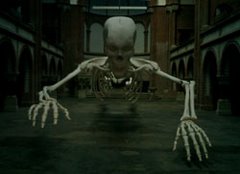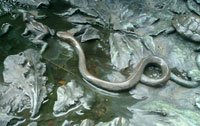 The California Condor (Gymnogyps californianus) is a surviving member of the genus Gymnogyps. These giants birds roamed the Americas in the Pleistocene epoch living off megafauna carcasses.
The California Condor (Gymnogyps californianus) is a surviving member of the genus Gymnogyps. These giants birds roamed the Americas in the Pleistocene epoch living off megafauna carcasses.The 19th and 20th century brought destruction of this vulture and its habitat:
- In the California Gold Rush, condors were kept as captive pets
- Eggs were collected
- They got poached as museum specimens
- They suffered lead poisoning (from eating animals containing lead shot)
- DDT poisoning
- Electric power line electrocution
- Being shot at
- Habitat destruction and fragmentation
" Today 70 percent (53 out of 76) of condor moralities can be attributed to human influences...For nestlings (birds younger than 6 months of age), 73 percent of known mortalities can be attributed to the consumption of microtrash, such as bottle caps and small pieces of broken glass, plastic and metal. Lead toxicosis, from the ingestion of spent ammunition, was the most important factor in juvenile condor mortality (birds between the age of 6 months and 5 years) and was the only significant cause of death in adults (birds 6 years old and older). Eight of 23 birds that died of lead poisoning still had metal or lead fragments in their gastrointestinal tract."Image
Condor (Sarcorhamphus gryphus) Brehm, Alfred Thierleben via Zeno
video
See
Shooting endangered Eagles







